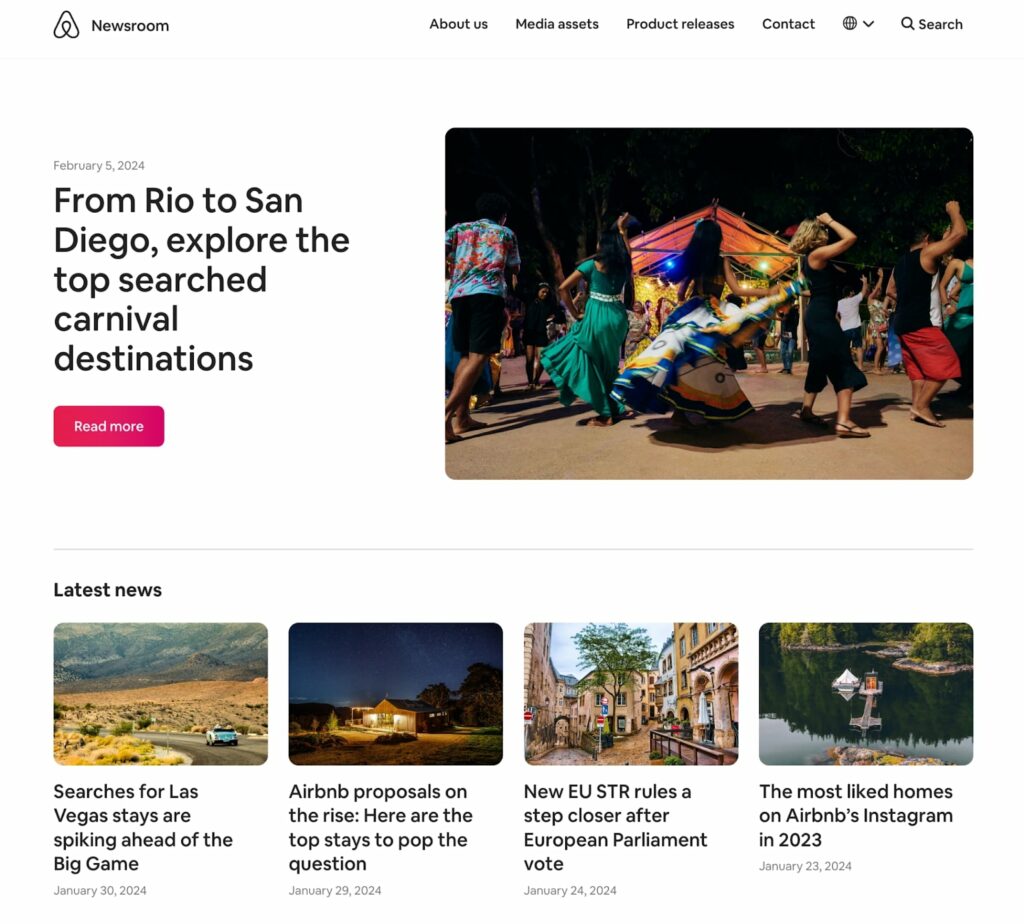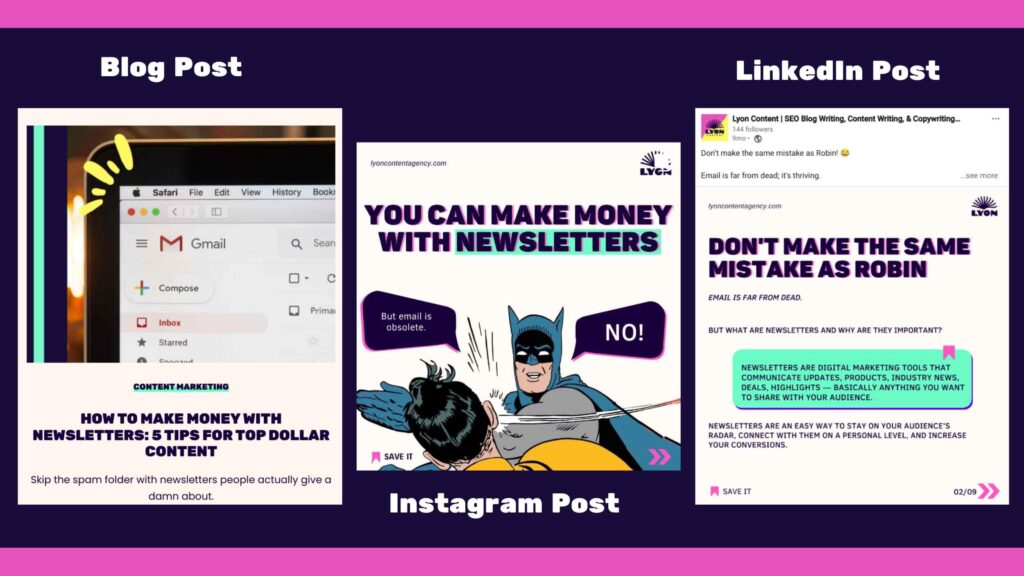What you’ll learn
People have been saying that blogging is dead for years.
But blogs have survived social media, remained relevant amid viral video content, and duked it out with AI. So when you ask me “Is blogging dead in 2024?,” my short answer is no. The long answer:
Blogs build brand awareness and attract ideal readers with value and information. And that information is a digital currency that generates trust and sales.
Disregard blogs as a viable top-funnel marketing channel? You’ll only undermine your growth in 2024 when people crave authenticity.
But do people still read blogs? Yep! Hubspot shares that blogs are still a top marketing channel unleashing mega ROI, and 60% of people read blogs once a week at least.
As an award-winning content writing agency, we’ve helped our clients drive serious ROI and crush SERP rankings with consistent blogging.
So is blogging dead? Before you read its eulogy, read this article.
Why are blogs still relevant in 2024? 7 key reasons
Last year, the tech bros proclaimed brands could fire their copywriters and have robots write their content for free. Yet Google won’t consistently rank AI-generated fluff. Why? Search engines rank articles and content that exhibit the highest value.
So, are blogs still a thing in 2024? Yep, and for several reasons:
- Blogs humanize your brand
- Build brand awareness
- Increase web traffic
- Raise search engine rankings
- Build a recognizable and trustworthy brand
- Convert to sales
- Great for repurposing content
Let’s dig into these.
1. Blogs humanize your brand
In the face of constant automation and copy-paste ideas, it’s no surprise people crave authenticity. Blogging is a kickass way to exude your brand personality and stand out from other brands.
And the stats back this up: 86% of people align with brands they perceive as authentic.
The war on authenticity rages with the rise of robo-writers. This means you actually have a great chance at standing out because while others take the shortcut, you can publish quality, unique content that forges lasting connections with your audience.
2. Helps you build brand awareness
Planning to launch a sister company for your hair product brand, and want to get the word out?
You fire off a newsletter to your subscribers. Perfect!
But that’s info delivered to your existing audience. Meaning, you’re not reaching a new pool. So it’s time to cast a wider net by starting a blog and announcing your brand with a new blog post.
After all, blog posts are perfect lead generators. Say someone types a query into Google search, like “how to get smoother hair,” and you sell natural hair serums. You can publish a post about the benefits of hair oils, and connect with that reader who’s in the beginning stages of the customer sales funnel.
Is blogging dead, then? No, because successful blog posts build brand awareness and trust in more ways than one. Take that blog post example above and consider that this searcher wants to compare your product to your competitors’.
1: You could write a comparison post (it works, I promise. You’re reviewing your competition, rather than shying away from them)
2: You have an active, educational blog that provides industry insight and expert help on your audience’s biggest struggles. Your knowledgeable content helps the reader build trust enough to proceed with a purchase.
And your competitor? No blog to be found. Or, they’re pumping out impersonal AI posts. Or, they lack data-driven SEO strategies to really reach their intended audience.
All great opportunities to build authority and seal the deal with these leads.

3. Increases web traffic and SERP rankings
I’ve worked with a lot of startups over the years. The one thing on every small business owner’s or marketer’s mind, aside from becoming profitable?
Website traffic.
Getting web traffic as a new business is often painstaking. You launch a beautiful new site, have stellar products or services, yet no one knows about it.
C’mon Google gods, shine your light on us, they gripe.
While the fruits of SEO content writing and blogging can take 6-12 months to kick into high-gear, you will see traffic rolling in with value-packed blog content bolstering a solid keyword strategy.
For example, we used long-form blog posts to drive a 104% year-over-year (YoY) increase in organic traffic for our alternative hair beauty client.
The same people who ask “is blogging dead?” also wonder, “is SEO dead?”
Setting KPIs and SEO goals
Like any marketing campaign, it’s important to set key performance indicators (KPIs) for your blog strategy which outline key ranking factors like your target audience, domain authority, and backlinks.
Let’s say you have a retail business that attracts a lot of local SEO attention to your site. Yet your online store could stretch beyond your neighborhood with blog trending topics relevant to your target audience.
For instance, just because you sell bathing suits in Huntington Beach, CA doesn’t mean So Cal beach-lovers are your only market.
You could create an effective blog content strategy with keyword-rich topics to reach shoppers in Florida and South Carolina, too.
Why limit your reach? Blogging makes your website more visible and brings in more traffic overall. Meaning? You’ll start to climb up the search engine results page (SERP) so more people find your business.
Who doesn’t want that?
4. Builds a recognizable and trustworthy brand
All this brand awareness you build is going to translate to trust and recognition. People are reluctant to buy from new businesses that lack social proof.
This is why 50% of people buy from brands with recognizable logos.
When you blog regularly, you invest in your target audience’s needs and interests. Plus, you’ll share relevant statistics, industry knowledge, and insider hacks they can’t learn elsewhere.
Check out Airbnb’s Newsroom (their company blog).
Airbnb may be the vacation rental company to beat, but with VRBO and hotels nipping at their heels, they maintain customer trust with an active blog about top destinations, most liked homes, and trending search data.

5. Converts to sales
While traffic gains boost visibility, you want a meaty percentage of these web visits to convert to sales.
One of the biggest reasons why blogging isn’t going to die in 2024 is because brands still need to create top-funnel content to capture casual visitors.
Why? Because people aren’t going to just hit “buy now” without any incentive or trust.
Your blog is a lead generator attracting new traffic and building trust with those visitors. Over time, and with consistent blogging that’s targeted around data and competitor research, you’ll move the needle on conversions.
6. Great for repurposing content
Content is absolutely necessarily for every brand. And people consume it in more ways than one. This can make crafting a cross-channel marketing strategy a complex task.
How can you reach audiences on multiple channels without blowing through your marketing budget?
With repurposed content.
Blogs lend themselves well to repurposing. They’re long (anywhere from 1,000-3,500+ words) and contain multiple talking points within the primary subject.
So chop them up and use their bits in other parts.
Instead of creating five content pieces (a video, infographic, newsletter, web page, and ad) from scratch, you can take one blog post and break it into dozens of pieces of content.

I don’t see this convenience losing its appeal to marketers in 2024.
Ready for me to spill some tea on blogging tactics you can send to the grave this year?
6 blogging tactics that don’t work anymore + what to do instead
Whenever we approach the end of the year, the discussion of “is blogging dead” trends again. And this year, it’s especially unsurprising.
So we’ve made the case for blogging in 2024 — but what made everyone so skeptical? Poor blog performance comes from poor blogging practices, like bad user experience, too much sponsored content, and thin topics, which we won’t do for SEO blogging in 2024.
We’re also leaving behind:
Clickbait headlines
What is this, 2016?
Clickbait headlines promise value and deliver BS. It’s the classic bait and switch technique. You read a seductive headline like “We Tried the Viral Collagen Mask, You’ll Never Believe What Happened” and of course you click on it. We’re curious creatures.
If you deliver on a headline’s promise with an in-depth, relevant, and trustworthy article for the reader, great!
But if your goal is to get clicks without offering substance? We’ll bet you’ll skyrocket your bounce rate. When that happens, Google notices and dings you with lower rankings, decreased visibility, and a damaged reputation. Ouch.
What to do instead:
Write honest, creative headlines. A little pizazz is OK, but accuracy and content relevance come first. Your titles should describe what the searcher will find when they click on your link.
Is your article about wellness tips for elderly women?
Then please, don’t pen a headline in the vein of “This One Simple Hack Will Turn Back The Clock & Give You 10+ Years of Life.”
It’s irresponsible and shady. Instead, be authentic:
“10 Wellness Tips To Enhance Quality of Life in Elderly Women”
See the difference?

Ditch an SEO strategy and lack focus on your blog
If you’re a PPC marketing agency, you should probably write helpful digital marketing content, not blog updates about roofing trends or opinionated think-pieces that offend your readers.
Even if you do write relevant content for your business blog, you might miss out on results with a misguided SEO strategy, vague keywords, or a poorly managed content calendar.
Instead, your blog should follow well-informed keyword research and SEO strategy. This is how you make sure your content appears when your audience types queries into Google.
What to do instead:
A focused, successful blog always starts with knowing your target audience. Understand how they think and talk, and this will inform the content you write. Audience research also helps you shape your brand tone of voice and messaging guidelines, which sharpens your copy and brand positioning so that you can best reach people most likely to buy your products.
Use your brand messaging guidelines to create focused blog content that attracts the right audience. Otherwise? You risk bringing in traffic that only feeds vanity metrics (sexy numbers that don’t actually lead to sales).
Those brand messaging guidelines? They also form the foundation of your SEO blog strategy.
A blog strategy starts with keyword research and builds out topic clusters. At the heart of this strategy is the goal to help the real people behind your customer personas.
Imagine you sell luxury, medical-grade skincare, but write topics about cheap skincare routines. The math ain’t mathin’, as they say.
Also:
- Conduct audience research to learn your target audience’s most pressing questions and user queries.
- Check out discussion forums to see what people are talking about
- Send out customer surveys to ask them what they want to learn more about.
- Scour competitor blogs and look for content gaps.
- Use keyword research to find which topics have search volume data.
- Gel all of this intel together into a solid SEO blog strategy
This is all the basis of a well-rounded brand messaging and SEO strategy.
I get it; SEO tactics are a ton of work. Good thing we’ve perfected our content writing system to channel a bangin’ SEO strategy for every blog. We’re ready to help.
Choosing quantity over quality (and pumping out AI posts)
While Google doesn’t discriminate against AI-generated content (they have their own AI, Bard, after all) they do penalize what they deem as low-quality content.
Low quality = Thin, flimsy, regurgitated, unoriginal content that lacks relevant research and value.
Focus on sheer output over value and you’ll probably diminish authority, lower brand visibility, and get shadowbanned (relegated to the back pages of Google).
What to do instead:
Publish high-quality content. It’s called E-E-A-T, and it demonstrates Experience, Expertise, Authoritativeness, and Trustworthiness.
Google rates content based on these markers to ensure your content is helpful and relevant.
Here’s how to flex some serious E-E-A-T:
- Experience: Interview your team, use these quotes in your post, and link to their LinkedIn profiles to show their credibility
- Expertise: Bring concepts to life with case studies from your business
- Authoritativeness: Publish rich informational pieces about topics you’ve mastered
- Trustworthiness: Get backlinks from key industry players, do podcast or article interviews and repurpose those into blog posts.
SEO without value
Lastly, the days of keyword stuffing and writing for search engines over humans are long gone. And good riddance.
While you can absolutely use AI to streamline your keyword research and blog topic outlining, don’t let that be the extent of your research.
What to do instead:
Always write for human readers over search engine crawlers. Offer value and the SEO results will come organically.
Here’s how to ensure you’re leading with value:
- Do audience research. Learn what’s important to your readers.
- Scope out the SERP results for the topic you’re writing about. Look at the sections covered and include them in your blog in an authentic, unique way.
- Add new sections you think will enhance the value. What’s missing from the existing SERP results? Can you add an FAQ or interview Q&A with an industry insider or someone on your team to build authority?
- Use keywords and queries naturally. If it’s not readable or articulate, don’t include it.
- Get an extra set of eyes. Have an objective colleague (or editor) review your work for accuracy, flow, and composition.
But exceptional, high-quality content takes time to create. You might not have it, but our staff of talented writers and editors sure do. Level up your blog with expert content writing services.

Publishing blogs without video or audio content
With Google’s Search Generative Experience rolling out mid-2024, the search engine giant will now generate the most relevant and helpful content at the top of the SERP. That’s right – before the organic results.
But in its quest to gather the best intel, Google’s calling on images and especially video to pull up the most accurate info.
The Verge elaborates:
“Google has integrated YouTube more and more into search results over the years, linking to a specific chapter or moment inside a video that might help you with that “why is my dryer making that noise” query.”
Think you can write the world’s most insightful article about all the potential reasons your dryer is making noise, and publish it without interactive media, and still show up on the SERP? Think again.
What to do instead:
Allocate a portion of your content marketing budget for high-quality and helpful video content. You don’t need a $40K studio and Hollywood film crew. You can even take your article, repurpose it into video slides, record a simple voice-over, and share that to YouTube.
The point is to expand the mediums you use to disseminate information.
One of our favorite graphics tools for creating infographics, high-res images, and videos for our blog and social? Canva. Pssst… it’s free.
Relying solely on your blog to grow your biz
Most people on your blog are first-time web visitors not yet familiar with your brand. So, you can’t count solely on your blog to rake in the dough.
Continue to build an effective lead-generating blog strategy, but don’t stop there.
What to do instead:
Look for ways to broaden your reach and widen the lines of communication, like:
- Create an email newsletter to foster brand trust.
- Publish unique, engaging content on social media.
- Roll out deals and promotions to generate hype and urgency.
- Repurpose your blog content for cross channel marketing (into videos, infographics, and podcasts) to spark interest on multiple platforms.
The verdict: is blogging dead on arrival in 2024?
On the contrary! Blogging for business will continue to remain relevant so long as people use search engines to find information, products, and news.
But that doesn’t mean you want to count on the methods from yesterday to cast you into the spotlight today.
Follow the tips in this guide to create an evergreen blog strategy that soars through 2024 and beyond.
And while you’re here, say hello to your favorite content writers. We’ve got a heart that beats for blogging.
Ready to get more traffic? Let’s breathe new life into your blog.

03/14/2024
Christina Lyon is the founder and CEO of Lyon Content. She’s fired up for helping brands kickass online and grow their digital empires. Christina lives in So Cal with her husband and two dogs, and nerds out on reading, traveling, writing creative fiction, and getting lost in wild places. She’s obsessed with a good underdog story and eats more rice bowls than she’s willing to admit.




